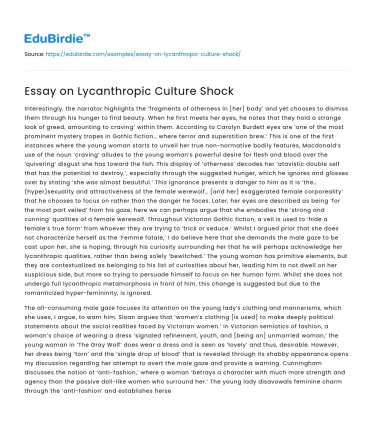Interestingly, the narrator highlights the ‘fragments of otherness in [her] body’ and yet chooses to dismiss them through his hunger to find beauty. When he first meets her eyes, he notes that they hold a strange look of greed, amounting to craving’ within them. According to Carolyn Burdett eyes are ‘one of the most prominent mystery tropes in Gothic fiction… where terror and superstition brew.’ This is one of the first instances where the young woman starts to unveil her true non-normative bodily features, Macdonald’s use of the noun ‘craving’ alludes to the young woman’s powerful desire for flesh and blood over the ‘quivering’ disgust she has toward the fish. This display of ‘otherness’ decodes her ‘atavistic double self that has the potential to destroy,’, especially through the suggested hunger, which he ignores and glosses over by stating ‘she was almost beautiful.’ This ignorance presents a danger to him as it is ‘the…(hyper)sexuality and attractiveness of the female werewolf… [and her] exaggerated female corporeality’ that he chooses to focus on rather than the danger he faces. Later, her eyes are described as being ‘for the most part veiled’ from his gaze, here we can perhaps argue that she embodies the ‘strong and cunning’ qualities of a female werewolf. Throughout Victorian Gothic fiction, a veil is used to ‘hide a female’s true form’ from whoever they are trying to ‘trick or seduce.’ Whilst I argued prior that she does not characterize herself as the ‘Femme fatale,’ I do believe here that she demands the male gaze to be cast upon her, she is hoping, through his curiosity surrounding her that he will perhaps acknowledge her lycanthropic qualities, rather than being solely ‘bewitched.’ The young woman has primitive elements, but they are contextualized as belonging to his list of curiosities about her, leading him to not dwell on her suspicious side, but more so trying to persuade himself to focus on her human form. Whilst she does not undergo full lycanthropic metamorphosis in front of him, this change is suggested but due to the romanticized hyper-femininity, is ignored.
The all-consuming male gaze focuses its attention on the young lady’s clothing and mannerisms, which she uses, I argue, to warn him. Sloan argues that ‘women’s clothing [is used] to make deeply political statements about the social realities faced by Victorian women.’ In Victorian semiotics of fashion, a woman’s choice of wearing a dress ‘signaled refinement, youth, and [being an] unmarried woman,’ the young woman in ‘The Gray Wolf’ does wear a dress and is seen as ‘lovely’ and thus, desirable. However, her dress being ‘torn’ and the ‘single drop of blood’ that is revealed through its shabby appearance opens my discussion regarding her attempt to avert the male gaze and provide a warning. Cunningham discusses the notion of ‘anti-fashion,’ where a woman ‘betrays a character with much more strength and agency than the passive doll-like women who surround her.’ The young lady disavowals feminine charm through the ‘anti-fashion’ and establishes herself as a problematic figure, disregarding ‘fashion as emblematic of patriarchal oppression and feminine helplessness.’ Patriarchal oppression is suggested at the beginning, through the hierarchy of the male being a student contrasted to the mute and solitary young woman. Immediately the power dynamic is exposed; powerful Victorian men exercised disturbing amounts of control over women who had no legal recourse thus allowing him to view her how he pleases. Yet, through the ‘anti-fashion’ defiance, we see how she navigates the extract away, for a brief moment, from his male gaze. When she returns with the ‘stain of blood’ on her leg she refutes his claim that she appears ‘washed’ and ‘better.’ She wishes him to see the other side of her, one that can be characterized as ‘Abhuman,’ making herself someone who is ‘not becoming not-itself [but] becoming other.’ The autonomous self-identity that characterizes the ‘Abhuman’ exposes itself when it feels a ‘threat’ toward itself is prevalent, she heightens her human traits, perhaps when she feels threatened by his gaze through her lycanthropic sitting on the chair ‘in an unusual position,’ her ‘nostrils’ that were ‘as tremulous as eyelids’ and her strangely ‘dazzling teeth.’ Perhaps he ignores her ‘otherness’ because of Victorian anxieties surrounding the human identity in regards to Degeneration, he was in a state of ‘horror’ after he heard the ‘pattering of dog’s feet’ and ‘spied [the] single drop of blood’ upon her bare leg, knowing himself that she perhaps who she presented herself as. Yet, in the following paragraph, he once more returns to being ‘bewitched’ by her.
Save your time!
We can take care of your essay
- Proper editing and formatting
- Free revision, title page, and bibliography
- Flexible prices and money-back guarantee






 Stuck on your essay?
Stuck on your essay?

